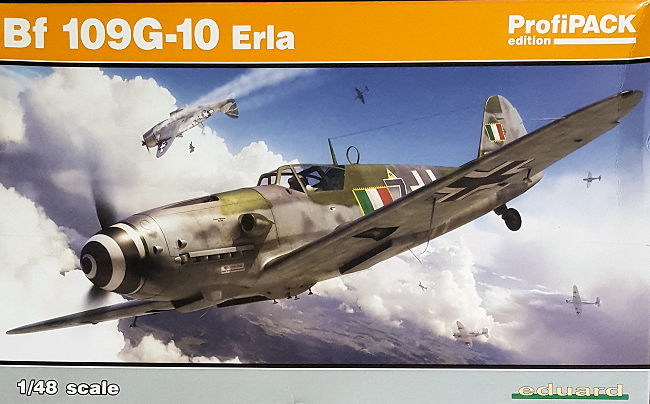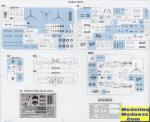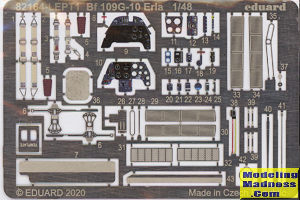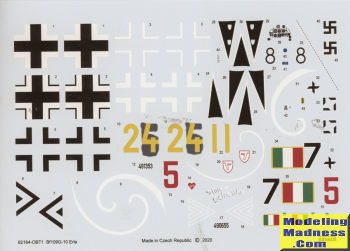
Eduard 1/48 Bf-109G-10 (Erla)
| KIT #: | 82164 |
| PRICE: | $49.95 SRP |
| DECALS: | Five options |
| REVIEWER: | Scott Van Aken |
| NOTES: | 2020 boxing |

| HISTORY |
Referred to as the "bastard aircraft of the Erla factory" in the Luftwaffe's Aircraft Variants Book of December 1944, the G-10 was a Bf 109 G airframe combined with the new DB 605 D-2 engine, created to maintain production levels with minimal disruption of the assembly lines until production of K-series airframes would reach sufficient levels. Despite what the designation would suggest, it appeared in service after the G-14 in November 1944, largely replacing previous G-series aircraft on the production lines of Erla, WNF and Messerschmitt Regensburg factories. Contrary to popular belief the G-10 were not rebuilt older airframes but new production. Early production G-10 may have had two data plates (one stamped G-14) as these airframes were originally intended for G-14 assembly but were diverted to G-10 assembly.
The most recognizable external change was the use of the three-panel Erla-Haube clear-view canopy, which filled the entire canopy length behind the four-panel windscreen unit, which eliminated the older, rear fixed canopy section. Internal changes included inheriting the new 2,000 W generator and the DB 605 D-2 engine of the 109K. Apart from the standardised streamlined engine cowlings, G-10s with the DB605 D-2 were equipped as standard with the MW-50 booster system (DB 605DM, later 605DB) and had a larger Fo 987 oil cooler housed in a deeper fairing. Also, because of the engine's enlarged crankcase and the oil return lines which ran in front of it, these G-10s had small blister fairings incorporated into the lower engine cowlings, forward of and below the exhaust stacks, except for Erla-built aircraft, which had modified cowlings without the little bulges in front of the exhaust stacks. This became a distinguishing feature between Erla-built G-10s and those of other factories. The radio antenna mast was also removed from atop the rear fuselage turtledeck, and replaced with a standard late-war Luftwaffe ventral whip aerial antenna under the wing. In addition, some had the wider wheels of the K model which meant long wheel fairings atop the wings. Some also had the long tail wheel leg while others retained the shorter version.
The following variants of the G-10 were produced:
Approximately 2,600 G-10s were produced from October 1944 until the war's end.
| THE KIT |
 This
is a continuation of a series of Bf-109Gs that Eduard has been producing. Not
surprising is that you are provided with many of the same sprues as the G-6 and
G-14. You do get complete fuselage halves that have the distinctive Erla
cowling. I is what has been called the 'type 110' as the paneling on the pilot's
side does not curve upward but is flat.
For
an example, the Revell 1/48 109G-10 has the other type.
This
is a continuation of a series of Bf-109Gs that Eduard has been producing. Not
surprising is that you are provided with many of the same sprues as the G-6 and
G-14. You do get complete fuselage halves that have the distinctive Erla
cowling. I is what has been called the 'type 110' as the paneling on the pilot's
side does not curve upward but is flat.
For
an example, the Revell 1/48 109G-10 has the other type.
 The cockpit
is well appointed and this is where a fair amount of the p.e. is used. When
closing the fuselage halves, you have to make a couple of choices. One is that
you have a choice to use the p.e. exhaust shields or the plastic ones. As
the exhaust installs from the inside, that choice has to be made at this time.
Secondly, if you are to do the options with the tall tail gear, this is when it
gets installed. One option has the shorter one and that can be attached later.
The cockpit
is well appointed and this is where a fair amount of the p.e. is used. When
closing the fuselage halves, you have to make a couple of choices. One is that
you have a choice to use the p.e. exhaust shields or the plastic ones. As
the exhaust installs from the inside, that choice has to be made at this time.
Secondly, if you are to do the options with the tall tail gear, this is when it
gets installed. One option has the shorter one and that can be attached later.

Markings are provided for five aircraft. One is the
box art plane with the ANR. This one has the short tail wheel. A second is an
Eric Hartmann plane from the end of the war. Then one
| CONCLUSIONS |
A nice addition to Eduard's growing 109 collection and while it doesn't obsolete previous kits from Hasegawa, it does have a bit more detail. It also will give you a lot of 109 spares.
| REFERENCES |
https://en.wikipedia.org/wiki/Messerschmitt_Bf_109_variants#G-10
November 2020
If you would like your product reviewed fairly and fairly quickly, please contact the editor or see other details in the Note to Contributors.
Back to the Main Page Back to the Review Index Page Back to the Previews Index Page